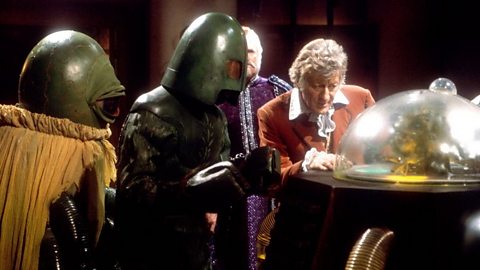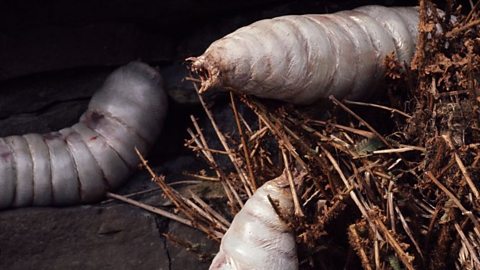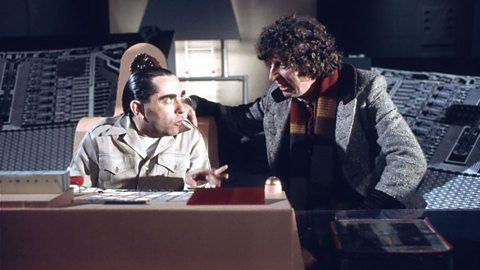Youâd be forgiven for thinking that Doctor Who is a sci-fi show packed with action, monsters and unbeatable cliffhangers - light years away from the worldâs biggest news stories.
But throughout its 60-year history, there have been moments where, intentionally or otherwise, the time-travelling series has echoed events in the real world.
To mark Doctor Whoâs 60th anniversary, ±«Óătv Bitesize takes a look at the times our Time Lord experienced adventures which had something in common with the national, and occasionally international, conversation.
The Curse of Peladon: The UKâs entry into the EEC
In 1972, the United Kingdom signed the treaty that would allow it to become a member state of the European Economic Community (EEC) on 1 January 1973. The EEC would be later known as the European Union (EU) and it was a Groups of countries that form agreements on how to trade between themselves. the UK had been trying to join since the early 1960s, when its membership had been vetoed by French president Charles de Gaulle on two occasions.

Also in 1972, the TARDIS, piloted by the Third Doctor, Jon Pertwee, accompanied by companion Jo Grant (Katy Manning) arrived on the planet Peladon. It was a moment when the planet was set to become part of the Galactic Federation, with delegates from Alpha Centauri and Arcturus visiting ahead of any formal agreement. The Doctor and Jo are mistaken for the Earth delegation and the previously villainous Ice Warriors also show up, except this time theyâre on the goodiesâ side as ambassadors from Mars.
The sleeve notes on the official ±«Óătv DVD release of The Curse of Peladon describe the story as âa cheeky political allegory, made at a time when the UK was on the verge of joining the EEC.â However, in an interview, the showâs then script editor, Terrance Dicks, said: âObviously, the parallel is there to be drawn. It may have been in Brian [Hayles, the writer]âs mind - it certainly wasnât in mine.â
The Green Death: Ecological concerns
Pollution - and the importance of looking after the planet - regularly cropped up in global headlines and causes in the 1970s.
In 1973, along came a Doctor Who adventure called The Green Death. Set in South Wales, itâs about the mining village of Llanfairfach, chosen by the Global Chemicals corporation as the site of its new premises. Its writer, Robert Sloman, said in one interview: âBarry [Letts, the producer at the time] wanted to do [a story] about the state of the country and what we were doing to it. It became quite clear to me⊠that we are destroying the planet.â

Unfortunately, Global Chemicals is being run by an evil computer called BOSS and its waste products are pumped into the mine. This has the joint effect of making anyone who touches it turn a vivid shade of lime green and become dangerously ill, as well as producing giant maggots with snapping fangs.
Without wishing to spoil the ending, a big part in preventing the spread of the Green Death comes via a meat alternative fungus farmed by Llanfairfachâs small community of (what we would now call) eco-warriors. Self-sufficiency, or living off the land, was a popular concept in the 1970s - it also inspired ±«Óătv sitcom The Good Life.
The Monster of Peladon: Minersâ strikes and womenâs rights
Peladon was proving a positively An allegory is a story that has a hidden meaning, usually a political one. planet for the TARDIS to materialise. In 1974, it again provided a setting for the Third Doctor to get caught up in an adventure with shades of current affairs.

In 1972, coal miners in the UK went on strike in an attempt to receive increased wages and improved working conditions. It was the biggest industrial action in the country since the The largest industrial dispute in UK history. It was called on 3 May 1926 by the Trade Union Congress and saw millions of workers striking over low pay and poor working conditions. The strike lasted nine days. of 1926. When the Doctor returned to Peladon, its miners had downed tools over working conditions.
The serial, written again by Brian Hayles, was broadcast less than three weeks after a second mining dispute in the UK had ended. It began in the winter of 1973 and led to a four-week strike in early 1974 - resolved after a 35% rise in pay was offered by the new Labour government.
Had Doctor Who ever been more topical? Well, perhaps. Producer Barry Letts said on the storyâs DVD release, that the industrial action taking place when Brian Hayles was writing this story: ââŠwere the first minersâ strikes since the General Strike in 1926, so they were a very big thing in our lives.â - it may have inspired Haylesâ script, but there is no definitive proof.
Away from the mining storyline, a memorable scene from The Monster of Peladon shows the Doctorâs new companion, the independent-minded journalist Sarah Jane Smith (Elisabeth Sladen) giving Peladonâs Queen Thalira a pep talk on womenâs liberation. This was another movement that grew in the 1970s, and its first conference took place in Oxford in 1970.
When the Queen tells Sarah she is âonlyâ a girl having to deal with a major crisis on her planet, Sarah reminds her: âThereâs nothing âonlyâ about being a girl, your majesty.â
The Sun Makers: Taxes and rising inflation
âThe Sun Makers was a skit on the A government department, now known as HM Revenue and Customs, which deals with the collection of taxes, among other roles. system,â its writer Robert Holmes once recalled. That certainly comes across in the story set on the fictional Pluto city of Megropolis, with a corridor called A government certificate or statement showing how much tax someone has paid so far that year. It is usually given to someone as they leave a job., guards called the Inner Retinue and the villainous Collector - intent on taxing the city workers on anything and everything at increasing rates - and putting his enemies through a nasty process called In financial terms, the process of bringing a business to an end. Anything of value is shared between those the business owes money..

In an interview on the official DVD release of the story, its director, Pennant Roberts, says Holmes wrote The Sun Makers in retaliation over a tax bill.
When this story was broadcast in November 1977, the basic UK income tax rate was 34%, almost three-quarters more than the 20% set for the 2023/24 tax year. The world economy had been hit by an oil crisis earlier in the decade which drove up costs due to fuel shortages. There was high unemployment, and an inflation rate of around 15%. By comparison, the inflation rate in Autumn 2022 was just under 11%, and around 6% by summer 2023.
In an attempt to generate more revenue for the economy in the 1970s, the The chief finance minister of the United Kingdom, based at 11 Downing Street. One of their main jobs is to set the country's annual Budget. at the time, Denis Healey, raised the tax rate for those on the highest incomes to 83%. This was not popular with many wealthier people and in a documentary on the ±«Óătv's DVD release of The Sun Makers, historian Dominic Sandbrook notes that when this story was made, there was a: "climate of anxiety and anger and kind of middle-class anti-tax sentiment in Britain."
This sentiment is perhaps best demonstrated in a conversation between The Doctor and his companion, the warrior Leela.
Leela: "These taxes? They are like sacrifices to tribal gods?"
The Doctor: "Well, roughly speaking. But paying tax is more painful."
Classic episodes of Doctor Who from the 1960s right up to the 2020s are available to watch on ±«Óătv iPlayer.
This article was published in November 2023.
The Doctor Who guide to Earth history
Just don't mention the Time Lord's involvement in your homework.

It's not just The Doctor: Regeneration in real life
As Jodie Whittaker prepares to leave Doctor Who - we take a look at bodily renewal that happens outside of sci-fi

Write your own Doctor Who theme
KS3 Music
